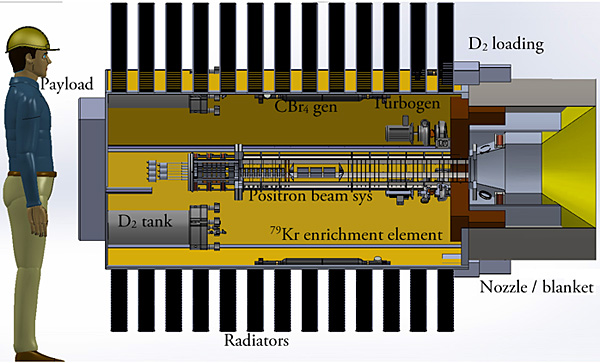August 27, 2019
Starhopper Hopping


"Sandblasting a road to the future!"
Posted by: The Brickmuppet at
06:54 PM
| Comments (2)
| Add Comment
Post contains 8 words, total size 1 kb.
August 21, 2019
A Follow-Up on Positron Dynamics
Back in March we had a brief post on a company called Positron Dynamics and their claims to have solved the production and containment issues with antimatter regarding space propulsion.
Specifically, they are using positrons (anti-electrons) to catalyze a small fusion reaction. Positrons can be generated on the spot using a radioactive isotope of krypton, thus solving the antimatter storage problem, and being positively charged can be directed with a fair bit of ease solving the handling antimatter problem.
Now one of the Brickmuppet's Crack Team of Science Babes points us to a follow up to this story she found by months of diligent research...

Basically the conclusion is that it works, though the version that is looked at in the N.A.S.A report has much lower thrust than one would expect from something with the words "Fusion" and "Anti-Matter". Indeed, its thrust compares unfavorably to most ion drives.
However, it has the astonishing exhaust velocity of 2,943,000 meters per second and a Delta V (the change in velocity over the time an engine burns) of 60,000 meters per second. Now it burns a looong time and accelerates imperceptibly, but its DeltaV is actually better than some of the smaller Orion drive designs which involved using exploding atom bombs as propellant.

Note the diagram and the little object marked "D2 tank".
That's all the the Deuterium propellant needed for a 60,000 meter change of velocity. Yes the thrust is minuscule but over time it adds up. This is for a notional asteroid mission using the design as it is now.
The speed of New Horizons and the Voyager probes, the fastest things ever sent out by mankind is less than 17,000 meters per second.
Winchell Chung puts it thusly:
Or perhaps you could use a different engine (say a regular chemical engine) for emergencies. As an aside, the engineers seem to anticipate higher thrusts in the future but that is not mentioned in the peer-reviewed paper and must be considered to be speculation at this point.
There's a good deal of work still to do as noted at the end of the report, but it does now appear that this proposal to field an anti-matter propulsion system in the next few years is indeed practical.
Specifically, they are using positrons (anti-electrons) to catalyze a small fusion reaction. Positrons can be generated on the spot using a radioactive isotope of krypton, thus solving the antimatter storage problem, and being positively charged can be directed with a fair bit of ease solving the handling antimatter problem.
Now one of the Brickmuppet's Crack Team of Science Babes points us to a follow up to this story she found by months of diligent research...

"Actually, it was posted this morning over at Atomic Rocket"
Positron Dynamics submitted their report to N.A.S.A. for peer review this past January. It has now passed muster and is published in the N.A.S.A Rechnical Reports Server. There is a PDF of the report here for your perusal. Basically the conclusion is that it works, though the version that is looked at in the N.A.S.A report has much lower thrust than one would expect from something with the words "Fusion" and "Anti-Matter". Indeed, its thrust compares unfavorably to most ion drives.
However, it has the astonishing exhaust velocity of 2,943,000 meters per second and a Delta V (the change in velocity over the time an engine burns) of 60,000 meters per second. Now it burns a looong time and accelerates imperceptibly, but its DeltaV is actually better than some of the smaller Orion drive designs which involved using exploding atom bombs as propellant.

That's all the the Deuterium propellant needed for a 60,000 meter change of velocity. Yes the thrust is minuscule but over time it adds up. This is for a notional asteroid mission using the design as it is now.
The speed of New Horizons and the Voyager probes, the fastest things ever sent out by mankind is less than 17,000 meters per second.
Winchell Chung puts it thusly:
With many other propulsion systems, rocket designers are happy if the spacecraft is only 75% propellant and 25% everything else. A spacecraft with Radioisotope Positron Propulsion is pretty much 100% rocket and payload, the propellant is only a few micrograms. Granted that a one metric ton space probe with such an engine will have an measly acceleration of 0.0001 meters per second (0.0125 snail-power), but you can't have everything.
Be that as it may, the report compares their positron engine with an electric propulsion engine for a hypothetical capture/redirect of asteroid 2009BD and the positron engine kicks the electric engine to the curb.
Theoretically you can use multiple engine arrays if you must have a higher thrust.
Or perhaps you could use a different engine (say a regular chemical engine) for emergencies. As an aside, the engineers seem to anticipate higher thrusts in the future but that is not mentioned in the peer-reviewed paper and must be considered to be speculation at this point.
There's a good deal of work still to do as noted at the end of the report, but it does now appear that this proposal to field an anti-matter propulsion system in the next few years is indeed practical.
Posted by: The Brickmuppet at
05:35 PM
| Comments (1)
| Add Comment
Post contains 549 words, total size 5 kb.
<< Page 1 of 1 >>
29kb generated in CPU 0.0834, elapsed 0.1653 seconds.
69 queries taking 0.1471 seconds, 231 records returned.
Powered by Minx 1.1.6c-pink.
69 queries taking 0.1471 seconds, 231 records returned.
Powered by Minx 1.1.6c-pink.









